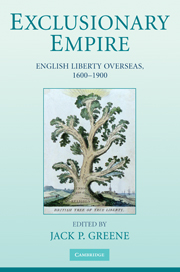Book contents
- Frontmatter
- Contents
- Notes on Contributors
- Preface
- Introduction
- 1 The Languages of Liberty in British North America, 1607–1776
- 2 Liberty and Slavery
- 3 “Era of Liberty”
- 4 Liberty and Modernity
- 5 Federalism, Democracy, and Liberty in the New American Nation
- 6 Liberty, Order, and Pluralism
- 7 Contested Despotism
- 8 “… a bastard offspring of tyranny under the guise of liberty”
- 9 How Much Did Institutions Matter?
- 10 The Expansion of British Liberties
- Index
9 - How Much Did Institutions Matter?
Cloning Britain in New Zealand
Published online by Cambridge University Press: 05 June 2012
- Frontmatter
- Contents
- Notes on Contributors
- Preface
- Introduction
- 1 The Languages of Liberty in British North America, 1607–1776
- 2 Liberty and Slavery
- 3 “Era of Liberty”
- 4 Liberty and Modernity
- 5 Federalism, Democracy, and Liberty in the New American Nation
- 6 Liberty, Order, and Pluralism
- 7 Contested Despotism
- 8 “… a bastard offspring of tyranny under the guise of liberty”
- 9 How Much Did Institutions Matter?
- 10 The Expansion of British Liberties
- Index
Summary
New Zealand is a long thin country in the South Pacific. It has no neighbors – Australia is 1,200 miles away. New Zealand is small relative to Australia, but it is larger than Britain and stretches for 1,200 miles through a variety of environments, ranging from subtropical to sub-Antarctic. In human terms it is perhaps the youngest country in the world; the first settlement, by Polynesians, appears to date back less than 1,000 years and European settlement less than 200. In these blinks of history's eye New Zealand has created two new peoples, the Polynesian Maori and the European “Pakeha.” These characteristics of small size, isolation, and youth make New Zealand historically translucent, a natural laboratory for the study of settler societies in general and British-derived ones in particular.
According to its mid-twentieth-century historical mythology, New Zealand developed along three steady and inexorable trajectories after it was acquired by Britain in 1840. The indigenous Maori were transformed from independent warriors to peaceful subjects; New Zealand nature was transformed from unproductive wilderness to very productive and surprisingly highly urbanized civilization; and white settlers were transformed from Britons into New Zealanders. All these changes did eventually take place; the mythical element lies in the notions of steadiness and inexorability. Early settler mass acquisitions of land, to the 1860s, were restricted mainly to the South Island. Most Maori lived in the North Island, and here they remained largely independent until about 1880.
- Type
- Chapter
- Information
- Exclusionary EmpireEnglish Liberty Overseas, 1600–1900, pp. 248 - 268Publisher: Cambridge University PressPrint publication year: 2009

